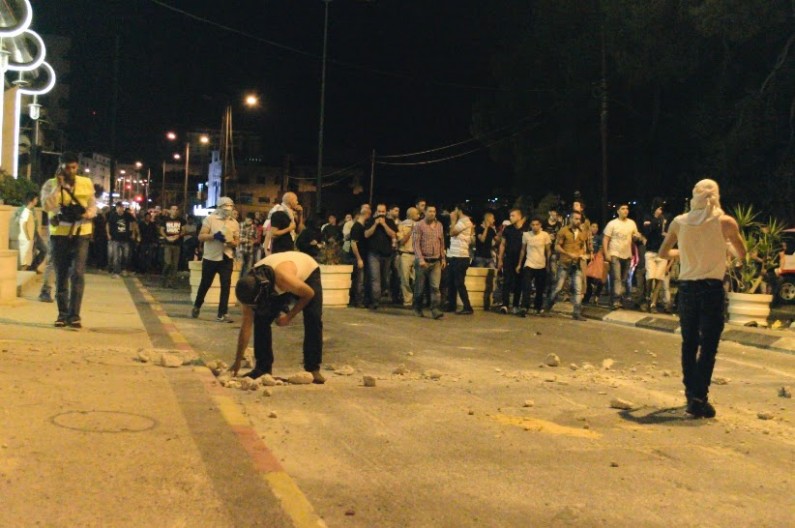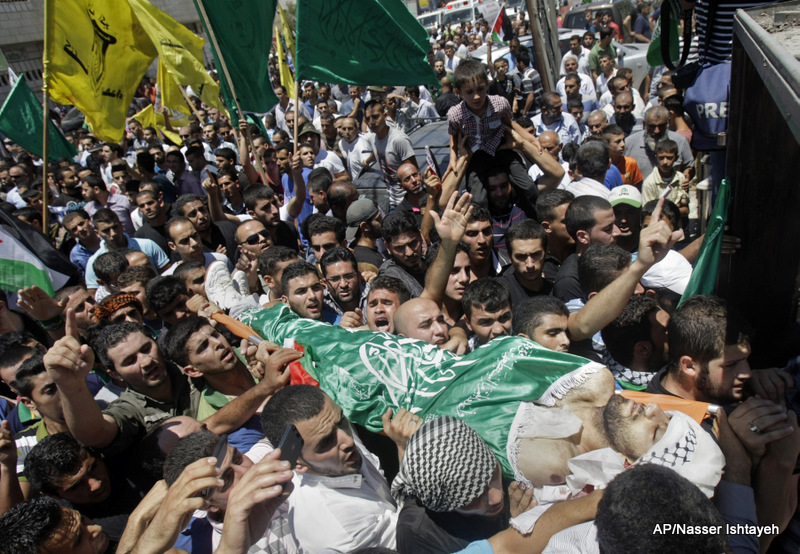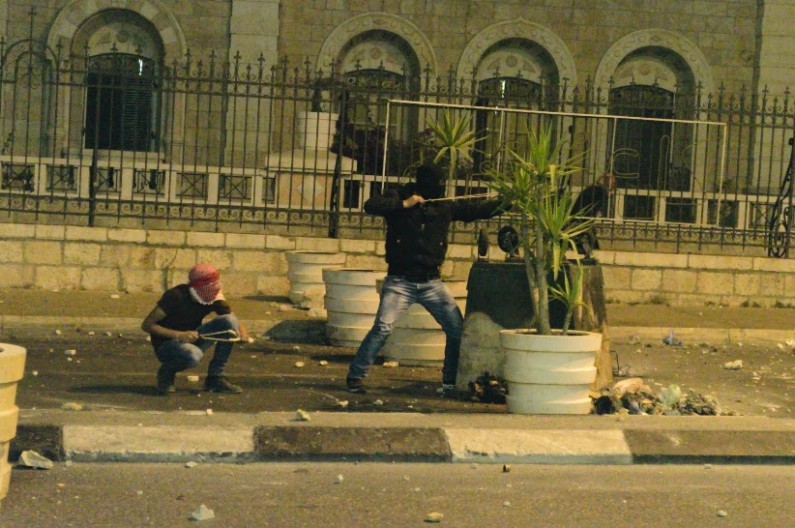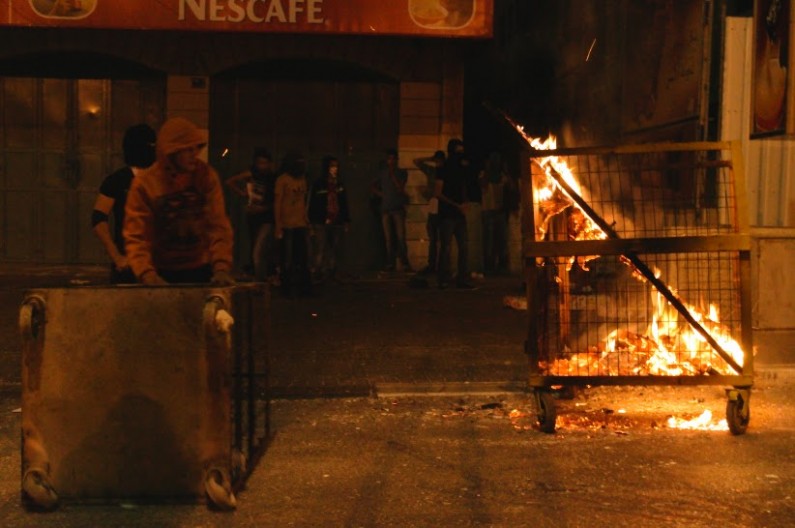BETHLEHEM, Occupied West Bank — The floors of the Ramallah Government Hospital were covered in blood on Thursday, as a steady stream of people injured in the largest protest to hit the West Bank in decades arrived for treatment.
Exposed to the nearly three weeks of Israeli shelling from land, sea and air that has ripped entire families and communities apart and left over 800 people dead, tens of thousands of protesters gathered together in Ramallah to march to the Qalandiya checkpoint on Laylat al-Qadr, known as the “Night of Destiny,” in a show of solidarity with their Palestinian counterparts in Gaza.
Fireworks and rocks ricocheted off buildings and walls as 200 of the frontline protesters marched forward and clashed with the Israeli Defense Forces, who fired gunshot after gunshot at the mass of protesters. The result was eight dead, and another 300 injured — half of whom injured by live ammunition.
Protesters described scenes of the IDF firing random shots into the crowds. Both those throwing stones and the thousands of people who stood on the sidelines chanting and cheering, they say, were being targeted by the IDF. Alaa Jadaa, a protester from Ramallah, told MintPress News that he believed he was witnessing the start of a third intifada, or uprising, in Palestine.
“The protest was so big, we gathered for Gaza, what’s been happening there and the bombing of all the people. So many have been killed. Even our president [Mahmoud Abbas] is just silent about Gaza. But people, like me, now believe this is the third intifada, there were even people with guns who came to Ramallah and they started to shoot toward the [Israeli] army,” Jadaa said.
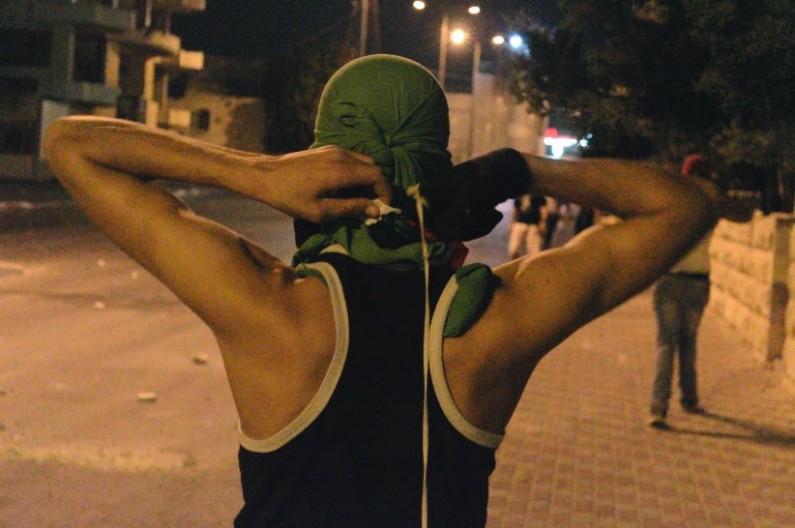
Talk of a third intifada has been circulating in the occupied West Bank and Jerusalem since the July 2 discovery of the body of Mohammed Abu Khdeir, a 16-year-old Palestinian boy who had been kidnapped and killed by Israeli settlers. But those murmurs have coalesced into a more palpable buzz with each passing day since Israel began its current military operation in Gaza on July 8. Thursday’s march in Ramallah turned that buzz into a full-blown belief that the third intifada had, in fact, begun.
That operation in Gaza — Operation Protective Edge — has been the worst military bombardment on the besieged strip of land since Operation Cast Lead, the 2009 Israeli invasion in which 1,600 Gazans were killed. As of Friday,over 1,000 Palestinians have been killed in the current operation and 5,240 have been injured, per figures from the health ministry in Gaza. Further, the United Nations Office for the Coordination of Humanitarian Affairs reported that within the first few days of the military offensive, 77 percent of the victims of Israel’s bombardment were civilians. That number, according to multiple human rights organizations, has stayed relatively constant. Also as of Friday, 35 Israeli soldiers and three Israeli civilians have been killed, and one Israeli soldier is missing — Hamas claims he has been captured by its armed wing, the al-Qassam Brigades, while Israel claims he is dead but his body has not yet been recovered.
The people of the West Bank are glued to their television sets, watching the horrors of war inflicted on their nearby Palestinian counterparts in Gaza. They are unable to join, or even see first-hand, what’s happening only 30 miles away, but the people of the West Bank are not staying quietly in their homes. Throughout the region, Palestinians are taking to the streets in nightly demonstrations for Gaza, standing up to what they call Israel’s unjust and deadly assault against civilians.
“We understand that coming out here every night, throwing rocks and choking on tear gas and being shot in our legs will not save Gaza,” Abdelrahman al Azah in Bethlehem told MintPress. “We understand that, but what can we do? Gaza is fighting for their freedom, for our freedom. To get your freedom sometimes you must fight. But what choice do they have under siege? We know this won’t save Gaza but we are all Palestinian, we can’t just sit and watch and be silent while our brothers are dying. If all we can do is scream in the streets then we will scream until we cannot scream anymore. We are all Palestinian.”
The mixed Christian-Muslim Palestinian city of Bethlehem is usually a quiet tourist hub, but it has exploded with clashes every night over the past three weeks. Like most Palestinian cities in the region, what began as demonstrations against the murder of Mohammed Abu Khdeir quickly intensified on the heels of the bombardment and later ground invasion of the Gaza Strip. The protests seemingly morphed overnight and drew bigger crowds of protesters chanting, holding signs and throwing rocks — all in the name of Gaza.
Residents of Bethlehem boast that their city is the only one that has held protests every day for the past three weeks, leading the way against the IDF in the West Bank and blazing a trail in establishing solidarity for Gaza.
“Before, it wasn’t the time for these protests, Israel was being quiet and there were not enough people to go out on the streets, but now it seems like the right time, and we have been there every night for Gaza and Palestine,” al Azah said. “But what happened in Ramallah was so big, we finished our protest and we saw the Ramallah one on the TV, it was crazy.”
Fareed, who chose not to identify himself by his full name, is a demonstrator in Hebron. He told MintPress that he watches news about Gaza all day, and when he is away from home, he uses his phone to keep track of what’s happening on social media.
“We keep watching the deaths rise,” Fareed said. “Some days it jumps by 100. I don’t know when it will stop. I can’t imagine what it is like for them in Gaza, they could die any day.”
Fareed said watching the news makes him feel hopeless because there is nothing he can do — he can only watch. Like al Azah, Fareed acknowledged that protests don’t do much for Gaza, but he said he takes pride in participating in the protests that generally turn into clashes with the Israeli army.
“Hundreds of people come out every night here in Hebron. We try to chant at the illegal settlement here because they are the closest we can get to who is responsible for this massacre in Gaza,” Fareed said. “The soldiers come, and some of us get shot, but it is better than being bombed. Gaza gets bombed and we get tear-gassed. What kind of sacrifice is this? It isn’t, but it is what we can do.”
The clashes around the West Bank have grown increasingly violent and dangerous every day. After one protester was killed in Ramallah on Thursday, marches on Friday around the West Bank resultedin another five deaths. Three Palestinians were killed in Beit Ummar during a confrontation between a march and the IDF, while teenager Khaled Yousof was shot dead by an Israeli settler during a peaceful march near Nablus. Clashes that occurred with the IDF after the settler shooting ended with another Palestinian death.
The action and inaction of the Palestinian Authority
The demonstrations in Hebron take place in an area that is designated as being under Israeli control, even though it is in the center of a built-up Palestinian city, so the Palestinian Authority has been unable to intervene. However, in the cities of Bethlehem and Ramallah, the PA has been vocal, and sometimes aggressive, in its opposition to the nightly protests.
The PA is usually unable to quell protesters, and it seldom tries to. But as nightly protests have continued and escalated across the West Bank, the PA has slowly been making a move.
By July 18, around two weeks into the Bethlehem protests, PA police started showing up in full riot gear, standing at the back and taking no action either for or against protesters. A few days later, PA officials came early to the protest and mingled with residents, speaking to people about ending the demonstration.
“People keep getting hurt here,” one PA police officer told MintPress. “Boys keep getting shot, businesses are being damaged, the whole place smells from the skunk water [canons] Israel shoots at them every night. We just want everyone to be safe.”
In recent days, the PA has tried to intervene and stop protesters, even lining up between them and the IDF. These attempts, however, have been largely unsuccessful. Instead of pushing demonstrators back, protesters surge forward, launching rocks and Molotov cocktails toward the police before rushing them, then starting clashes with the IDF.
In Ramallah, with over 150 injured by live fire and 300 injured in total, the PA managed to fulfil a different role: helping to create a cordon at Ramallah Government Hospital to help carry the many injured quickly through the chaos and into the confines of the building on Thursday night. However, many Palestinians have interpreted the PA’s tactics as collaboration with Israel, and this hasn’t gone unnoticed.
“They [PA] have helped with nothing, not for us,” Jadaa said. ”They help the Israelis before they help us. But Gaza doesn’t need them and we don’t. We will make the intifada without them. Everywhere is starting to protest, it was everywhere tonight, the biggest was here in Ramallah but all over, too. Everyone knows we need to unite to defeat this enemy, we need to unite.”